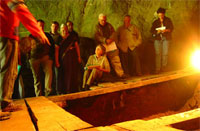Max Planck scientists decode the mitochondrial genome of a previously unknown hominin from the mountains of Central Asia
An international team of scientists from the Max Planck Institute for Evolutionary Anthropology in Leipzig has sequenced ancient mitochondrial DNA from a finger bone found in southern Siberia. The bone is from a previously unknown form of human that lived in the Altai Mountains of Central Asia around 48,000 to 30,000 years ago. This mitochondrial genetic material, passed down through the descendants in the maternal line, is a sign of a new wave of migration out of Africa, one that is distinct from that of Homo erectus, the ancestors of Neanderthals and Homo sapiens (Nature, 24 March 2010).
